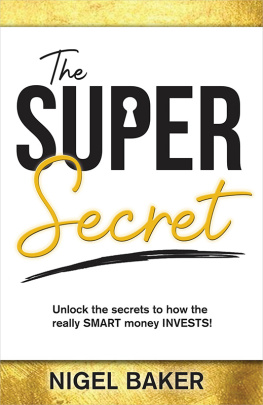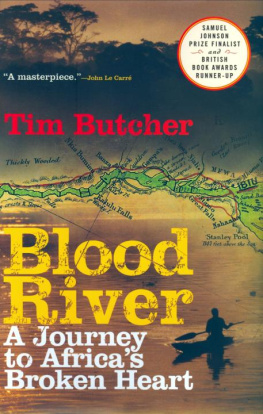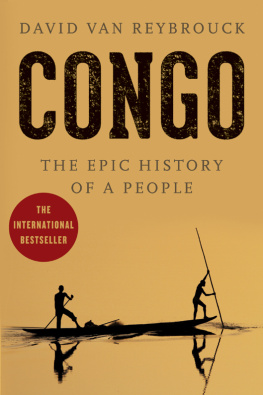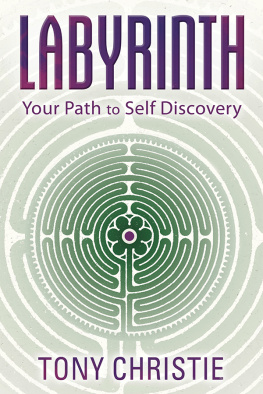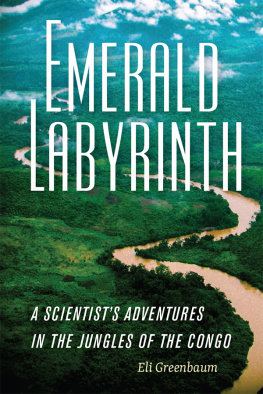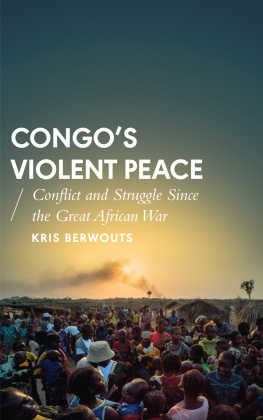Greenbaum - Emerald labyrinth a scientistsadventures in the jungles of the Congo
Here you can read online Greenbaum - Emerald labyrinth a scientistsadventures in the jungles of the Congo full text of the book (entire story) in english for free. Download pdf and epub, get meaning, cover and reviews about this ebook. City: Congo (Democratic Republic, year: 2018, publisher: University Press of New England;ForeEdge, genre: Romance novel. Description of the work, (preface) as well as reviews are available. Best literature library LitArk.com created for fans of good reading and offers a wide selection of genres:
Romance novel
Science fiction
Adventure
Detective
Science
History
Home and family
Prose
Art
Politics
Computer
Non-fiction
Religion
Business
Children
Humor
Choose a favorite category and find really read worthwhile books. Enjoy immersion in the world of imagination, feel the emotions of the characters or learn something new for yourself, make an fascinating discovery.
- Book:Emerald labyrinth a scientistsadventures in the jungles of the Congo
- Author:
- Publisher:University Press of New England;ForeEdge
- Genre:
- Year:2018
- City:Congo (Democratic Republic
- Rating:4 / 5
- Favourites:Add to favourites
- Your mark:
- 80
- 1
- 2
- 3
- 4
- 5
Emerald labyrinth a scientistsadventures in the jungles of the Congo: summary, description and annotation
We offer to read an annotation, description, summary or preface (depends on what the author of the book "Emerald labyrinth a scientistsadventures in the jungles of the Congo" wrote himself). If you haven't found the necessary information about the book — write in the comments, we will try to find it.
The race to explore the Congos dwindling biodiversity and unlock its ancient secrets
Greenbaum: author's other books
Who wrote Emerald labyrinth a scientistsadventures in the jungles of the Congo? Find out the surname, the name of the author of the book and a list of all author's works by series.
Emerald labyrinth a scientistsadventures in the jungles of the Congo — read online for free the complete book (whole text) full work
Below is the text of the book, divided by pages. System saving the place of the last page read, allows you to conveniently read the book "Emerald labyrinth a scientistsadventures in the jungles of the Congo" online for free, without having to search again every time where you left off. Put a bookmark, and you can go to the page where you finished reading at any time.
Font size:
Interval:
Bookmark:

LIST OF ABBREVIATIONS
Alliance of Democratic Forces for the Liberation of Congo: AFDL
Amphibian Survival Alliance: ASA
Avtomat Kalashnikov assault rifle: AK-47
Centre de Recherche en Sciences Naturelles: CRSN
Forces Armes Rwandaises: FAR
Forces Armes Zairoises: FAZ
Institut Congolais pour la Conservation de la Nature: ICCN
Institute for Scientific Research in Central Africa: IRSAC
International Union for the Conservation of Nature: IUCN
Lords Resistance Army: LRA
National Science Foundation (USA): NSF
Nongovernmental organization: NGO
Rassemblement Congolais pour la Dmocratie: RCD
Rocket-propelled grenade: RPG
Rwandan Patriotic Front: RPF
United Nations: UN
United Nations Educational, Scientific and Cultural Organization: UNESCO
United States Agency for International Development: USAID
Wildlife Conservation Society: WCS
ACKNOWLEDGMENTS
I am grateful to the people and organizations who supported my expeditions to Congo and the science that occurred when I returned, all of which is explained in this book. My benefactors included the Department of Biology at Villanova University, specifically Russell Gardner, Aaron Bauer, and Todd Jackman, who reluctantly gave me their blessing to run off to Africa when I should have been consummating my postdoctoral marriage to a DNA sequencer, which only briefly ceased to churn out gecko data during my four-week absence. That first trip was also funded by an IUCN/SSC Amphibian Specialist Group Seed Grant.
When I did not embarrass them by getting killed in some ghastly manner, Villanova funded me again the following year, this time for a ten-week expedition in the happy interim between the end of my postdoctoral work and beginning of my career as an assistant professor at the University of Texas at El Paso (UTEP). I also convinced Kurt Reed, MD, MGIS, a potential collaborator I had never met in person, to contribute finances to this trip. Using the momentum I gained from the first trip, I scored a grant from the Percy Sladen Memorial Fund, a trust fund set up by the widow of a marine biologist in England, which coincidentally funded the British Museum Expedition to the Ruwenzori Mountains almost exactly a century before my trip. That early twentieth-century expedition documented several new species of vertebrates on the Ugandan side of the glacier-capped Mountains of the Moon, whereas mine did the same on the Congolese side.
While returning from the latter trip and moving to El Paso, I learned that I would be able to combine funds from my new employer with those from the National Geographic Society, which funded my proposal to survey the stunningly beautiful Itombwe Plateau. This resulted in another ten-week expedition across eastern DRC in the summer of 2009, which was by far the most grueling trip for several reasons, not the least of which was a putative case of malaria that repeatedly stymied my efforts. This book is essentially the story of these two ten-week expeditions in 2008 and 2009. Much of the book was researched or written during downtime on subsequent expeditions to Congo, which occurred annually from 2010 to 2015.
For putting up with my wanderlust in isolated places, I am grateful to my family, who never questioned my purpose or sanity, at least in my presence, and demonstrated incredible fortitude and patience while I disappeared from all modern contact for weeks at a time. The lions share of my gratitude goes to my wife, Wendy Rivera Greenbaum, who married me despite my penchant for running off to Africa every year. Our late dog Jolie motivated me by providing plenty of affection during countless hours of research and writing. Wendy and several other family members read early drafts of some chapters and provided excellent feedback from the nonacademic viewpoint.
Of course none of my work would have been possible without the incredible dedication, generosity, and motivation of my Congolese friends, colleagues, and collaborators. It is impossible for me to express the enormous amount of respect and gratitude I have for my fellow herpetologist Chifundera Zacherie Kusamba. Chief or Chif, as he is affectionately called by our team, has an incredible understanding of the history, politics, and culture of Congos national parks and governmental institutions, and a political charisma that has allowed us to work in places where few other scientists have been able to penetrate. I owe my entire professional career in Congo to the lasting collaboration we formed in 2006, and his wisdom has certainly protected me from serious harm on several occasions. Mwenebatu M. Aristote is another indispensable member of the team. Intelligent and charismatic, Aristote lifted my spirits when the realities of Congo had stolen all my hope, he shielded me from a panoply of threats, and his loyalty is unparalleled. Wandege Mastaki Muninga is a gentle and happy soul who rarely complained during the worst of circumstances, his catlike reflexes in the jungle resulted in many rare animal captures, and he never seemed to run out of energy when everyone else (especially me) lay prostrate with exhaustion. Mululema Zigabe was an excellent driver and mechanic, and he performed several miracles on our battered Toyota to prevent us from being stranded on several occasions. Angalikiana Mulamba Marcel is a jovial grandfatherly figure who constantly managed to provide the team with nourishment and entertaining stories in the most remote places. I am also indebted to Maurice Luhumyo, John and Felix Akuku, and the late Asukulu MMema, who guided the team during our most difficult work in Itombwe. Baluku Bajope and Muhimanyi Manunu of the Centre de Recherche en Sciences Naturelles provided project support and permits, and we all thank the Institut Congolais pour la Conservation de la Nature for permits to work in protected areas. As of this writing, I have been extremely fortunate to have worked in Congo nine times (and Burundi and Uganda one and two times, respectively), and hope that the collaborations I have fostered can continue to flourish in the future.
As a white man working in Africa, and considering the shameful history of other white men in Africa, I fear it is impossible to convince every reader of this book that I have made every effort to be fair to the amazing Congolese people I have worked with over the years, but as imperfect as my efforts may have been, that was my goal. It is my sincere hope that my actions have improved the lives of the people (and their families) I have worked with, and that my work will be a great benefit to the country I have been privileged to know and love. Funds from my recent grant (DEB-1145459) from the US National Science Foundation (NSF) were used to obtain a dissecting microscope and other scientific materials for my African colleagues and students at their research center in Lwiro. Specimens we collected together were shared with the research and teaching collections at Lwiro, I participated in a training workshop for African park rangers, students and scientists in 2014, and we have published two dozen scientific papers togetherso far. The results of these studies are helping stakeholders prioritize conservation efforts in Congo and elsewhere in Central Africa. The latter point is the biggest benefit to Congo and the world, because conservation efforts are ineffective unless the stakeholders know which species they are conserving and where the threatened and endemic species occur. Chifundera has benefited from our successful research program in other waysthe international recognition of our publications has allowed him to acquire his own grants for conservation projects, and he recently obtained a position as director of the Itombwe Forest Conservation Initiative. As a testament to our friendship and collaboration, Aristote named his first son Eli, who was born on New Years Day in 2011 in the middle of our expedition to the mountains of Katanga. Despite these strong partnerships, I have never forgotten that I am a guest when I visit Congo, and I am grateful to the scientists, administrators, and government officials who have continuously invited me back year after year.
Next pageFont size:
Interval:
Bookmark:
Similar books «Emerald labyrinth a scientistsadventures in the jungles of the Congo»
Look at similar books to Emerald labyrinth a scientistsadventures in the jungles of the Congo. We have selected literature similar in name and meaning in the hope of providing readers with more options to find new, interesting, not yet read works.
Discussion, reviews of the book Emerald labyrinth a scientistsadventures in the jungles of the Congo and just readers' own opinions. Leave your comments, write what you think about the work, its meaning or the main characters. Specify what exactly you liked and what you didn't like, and why you think so.



